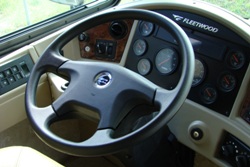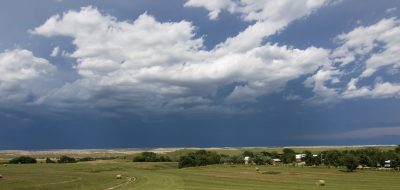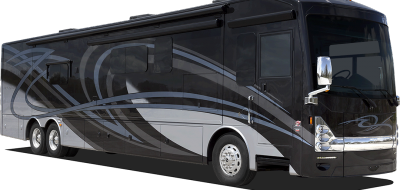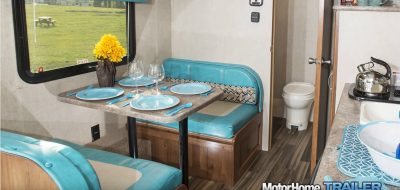 Did you know that forty thousand people in the United States die each year on the road! With the peak RV holiday travel season quickly approaching I thought this would be a good time to discuss getting to your RV travel destination safely. Getting there can be half the fun as the saying goes – if you take a few precautions to make your trip safe.
Did you know that forty thousand people in the United States die each year on the road! With the peak RV holiday travel season quickly approaching I thought this would be a good time to discuss getting to your RV travel destination safely. Getting there can be half the fun as the saying goes – if you take a few precautions to make your trip safe.
Here are a few safe driving tips:
The first step is to plan the trip you are taking. Travel guides, magazines, state tourism boards and Internet sites offer valuable information to help you plan your trip. Route your trip on a map or from an Internet trip planning site. Always keep an atlas or maps in the RV or tow vehicle. Driving a motor home or pulling a trailer can be stressful, especially if you don’t know the route you will be traveling. Using a GPS system can make traveling much less stressful.
**Note: Some of these tips apply to pulling a travel trailer, some apply to driving a motorhome and some apply to both.
*Complete a “Pre-Trip Checklist” before you head out on the road. Simple checks like checking your tires, lights, hitch work and other items all contribute to a safer trip.
*Take plenty of breaks when you’re traveling. Stopping, stretching out and taking brief walks can revitalize you. Do not rush to get to your vacation destination. Driving too fast and for long periods of time can result in fatigue and falling asleep at the wheel. If you feel tired you should pull over and rest or change drivers. It’s a good idea to switch drivers every few hours. Keep a window cracked open to help you stay alert, and only eat light meals when you stop to eat.
* Don’t speed. Driving at a moderate speed will put less stress and strain on the drive train components of your tow vehicle. It will also reduce the likelihood of the trailer becoming unstable and starting to sway.
*Avoid driving or pulling your RV during bad weather and high winds. Because of the size and mass of RV’s it can be extremely dangerous to travel during periods of high winds. It’s better to get to your destination one day later, than to risk traveling in bad weather.
* Limit your driving time to 5 or 6 hours a day (300 to 350 miles). Not only will you be more alert, but you will arrive at the campground with plenty of day light to get set up and settled in before it gets dark outside. This gives you a chance to unwind and get rested for another day of travel, and to enjoy some of the amenities the campground has to offer.
* Monitor the gauges on the tow vehicle or motorhome instrument panel. If a gauge does not read in the normal range pull over as soon as it is safe, and call for help.
* Drive defensively! Stay alert and monitor what is going on around you at all times. Use your mirrors. For increased visibility, purchase some convex mirrors that you can stick on your side view mirrors. These mirrors are inexpensive and are available in auto parts stores. They come in different sizes and will improve your visibility a great deal, especially along the sides of the RV and in blind spots. If you’re pulling a trailer it may be necessary to add mirror extensions so you can see along the sides of the trailer. The mirrors on your tow vehicle can be your best friend when you’re towing a trailer. When you use your mirrors you will know when a transfer truck is passing, and you can anticipate the need for a slight steering correction when the trucks air pressure causes the trailer to move. When you pass a vehicle, and can see the vehicles front tires on the road surface behind the trailer, it is safe to indicate and pull back in the other lane.
* Eventually you will have to pass another vehicle in your RV. It’s not difficult to pass but with a large RV it requires more space and time than the average automobile. Make sure you have plenty of room and use your turn signals to change lanes. Accelerate until you are past the other vehicle and you can see both of their headlights in your mirror. Signal again to return to the other lane and pull back in. Maintain your speed ahead of the vehicle you just passed.
* Always leave plenty of room between you and the vehicle in front of you. RV’s are much heavier than your automobile and require a longer braking distance to come to a stop. This alone will prevent accidents, especially during emergency braking. Driving at a safe speed also lowers your braking distance. Always use a supplemental braking system on the vehicle you are towing too.
* Use the proper gear for driving conditions. If the transmission continues to shift in and out of overdrive you need to turn the overdrive off. Reducing gears can help to slow the trailer or motorhome down when descending inclines and give you the additional power you may need when ascending inclines. **Note: Read the tow vehicle owner’s manual for proper gear selection when towing.
* Try to avoid sudden stops. Stopping to quickly can cause a trailer to slide and possibly jackknife.
* Try to avoid quick, harsh steering movements if possible. This can cause a trailer to become unstable and increase the possibility of trailer sway.
* Slow down on loose road surfaces, such as gravel, and when the roads are slippery and wet.
* When towing a trailer or a vehicle behind a motorhome you need to make wider turns than you are accustomed to. Remember the pivot point for the trailer is its axles. Watch for tail swing and exercise caution when turning on narrow streets and maneuvering around fuel stations.
* When maneuvering around the campground, watch for tail swing, low branches and utility hook ups.
* Cell phones are nice to have for emergencies, but they can distract the driver. Do not use a cell phone if you are driving. If you must make a call, have someone that is not driving do it for you.
Never drink and drive!
Plan your trip, travel safe and smart and enjoy your RV experiences. Remember, getting there is half the fun!
Happy and safe Holidays,
Mark Polk
Also, don’t forget to get your FREE RV DVD (s/h $5.95) The RV Orientation while supplies last





Darrel
Sorry, I addressed my message to Mark and it was intended for Drew. Sorry about that.
Darrel
Hi Mark, the nuvi 850 is another unit that has voice recognition. The only differences between the 850 and 880 is the 880 has BlueTooth and comes with the MSN Direct receiver. We sell the 850 for $590.00 and the 880 for $675.00. Almost all of the GPS’s come down in price eventually. The 850 and 880 already has at least once.
Mark Polk
Hang in there Drew. As with all new technology prices start high and then drop off. When GPS units were first made available to the public pricing was high. I have noticed recently that GPS pricing is dropping off.
It’s funny, when I was in the military we relied on topo maps to get from point A to point B. Our new Jeep limited came with a built in GPS and sometimes I don’t know what I would do without it.
Happy Holidays
Mark
Drew Mueller
Mark,
I have finally taken your advice on purchasing a gps, but in reviewing all the models I’ve considered and tested- there is only one I’d buy right now, and its almost $700.00. This price is too high, and the more inexpensive units have too many flaws. I need to be able to simply drive and let the unit navigate through voice command…no other unit has shown to do this as effectively as the Garmin Nuvi 880. I guess I’ll wait until the price comes down. My time is worth alot, and so far I’ve spent many hours testing and reading. I’m done- unless someone has a better unit for less.